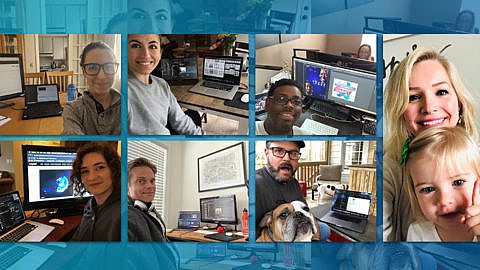We are all experiencing challenges due to the Novel Coronavirus / COVID-19 to varying degrees and workplaces around the world are making temporary adjustments to their work style. Encouraging social distancing by sending workers home to work remotely may seem daunting to employers and employees alike. Managers worry about lost productivity and a disconnected team, and as an employee, how are you supposed to focus on your inbox when there is laundry or a TV show right around the corner? According to CNBC, 7 out of 10 people around the world were already working remotely at least one day a week. While it may not be what you’re used to, temporarily working from home doesn’t need to interrupt your progress! Here are a few quick tips and healthy habits to help maintain your productivity:
Create A Workspace That’s Similar To Your Usual Set-up
Are you used to a wireless mouse, laptop stand, and second monitor at work? See if you can borrow these things from your office before sticking it out at home. If you aren’t able to gather the tools you’re used to, try hacking it! Use a box to create a standing desk at your dining table, or use a TV as large second monitor.
Sit at a table or desk, not the couch! If you’re used to sitting on the couch after work, chilling and watching the Mandalorian (like we all do), it will be harder to focus on work projects and staying in touch with your now-remote coworkers.
Clear your clutter. If your dishes, laundry, or literally any other household chores are distracting you, write out a list, then put the dishes, the laundry baskets, etc., out of sight. You can work through your list that evening after you’ve clocked out. Then the next day, your space will be free of distractions!
Use A Time Tracker
If you’re not used to using a time tracker for your projects, now is the time to start! This will help remind you which project you were working on when your coworker messages you with a question about something else. If you’re not used to working at home, you may feel like you are getting less done on long-term projects since you’re in more relaxed environment. A task timer can bring you comfort, knowing that you truly clocked those 8 hours!
Don’t Stop Communication With Your Team
Team members should not be “out of sight, out of mind”. Just because you can no longer lift your head and ask your teammate a question, you can’t put off that task you’re working on that needs their input. Make sure you reach out to your team early to establish which message system will be quickest. Keep your phone nearby in case you need to make or answer a quick phone call.
Follow Your Usual Routine As Much As Possible
Get up at the same time you usually do. Not only will this ensure your ability to be in an alert state of mind when your workday starts, it will help keep you on track for when you’re able to go back into the office.
Don’t stay in your pajamas (at least not after the first day…). Since you’ve woken up at your normal time, you have time to dress like a functioning human being! Dressing in casual work attire will help you focus and feel awake throughout the rest of your day. Starting off your morning by accomplishing the first task you usually do sets the tone for the rest of the day to operate as usual!
Take Short Breaks
Try utilizing the Pomodoro technique: 25 minutes of focused work, with a 5-minute break! Repeat this 4 times, and after the fourth round of 25 focused minutes, take a slightly longer break. Usually this is accomplished in an office environment by having a short conversation with your coworker about the big game (or the latest canceled game), making coffee in the break room, or preparing a little snack. Try to simulate this environment with natural breaks at home between intense periods of focus.
You may not be able to walk, stand, stretch, or do yoga in your office, but when you’re working from home, it’s easy! During these intermittent breaks, get up and stretch, go outside for a couple minutes, do arm circles, anything that will help wake up your brain and body. This way you can feel refreshed when you get back to it!
Be Flexible If You’re Sharing Small, At-Home Space
Keep your workspace tidy. Hopefully this is a given anytime, but be especially considerate of your space when you’re sharing your dining room table with your partner or kids who are also working or doing school at home. Try to create convenient working spaces for everyone to the extent that you can.
Discuss conference call rules. Establish areas away from noise for web conferences or live streaming, like a spare bedroom, laundry room, or even a large closet. Try putting on headphones and using chat features if multiple calls are happening at once.
This may be the most difficult part to working at home. If you’re stressed out or distracted, try looking at the tip above and take a short break to meditate. Keep on headphones, and maybe even use old boxes to set up temporary “cubicles” for everyone.
Work on turning these tips into habits during your work-from-home season, and you’ll be operating at 110% in no time!


